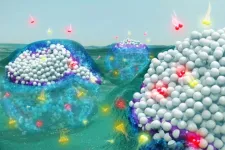(Press-News.org) WOODS HOLE, Mass. -- Egg cells start out as round blobs. After fertilization, they begin transforming into people, dogs, fish, or other animals by orienting head to tail, back to belly, and left to right. Exactly what sets these body orientation directions has been guessed at but not seen. Now researchers at the Marine Biological Laboratory (MBL) have imaged the very beginning of this cellular rearrangement, and their findings help answer a fundamental question.
"The most interesting and mysterious part of developmental biology is the origin of the body axis in animals," said researcher Tomomi Tani. An MBL scientist in the Eugene Bell Center at the time of the research, Tani is now with Japan's National Institute of Advanced Industrial Science and Technology.
The work by Tani and Hirokazu Ishii, reported this week in Molecular Biology of the Cell, shows that both parents contribute to the body orientation of their offspring. For the animal species studied in the research (sea squirts), input from the mother sets the back-belly axis while that of the father does so for the head-tail axis.
"Both the maternal and the paternal cues are required to establish the body plan of the developing animal embryo," stated Tani.
This research addresses fundamental questions in developmental biology and may also provide clues as to why things sometimes go wrong. Such knowledge could benefit fields as diverse as medicine and agriculture.
The prevalent theory of how the body axis is set has been that actin filaments inside the egg, which are involved in cell motion and contraction, power the rearrangement of cytoplasmic material in the egg after it has been fertilized. But seeing this happen has been a challenge because the onset of the process takes place rapidly and over very small distances within living cells.
To overcome these hurdles, Tani and Ishii used a fluorescence polarization microscope, a technology developed a few years ago at MBL by Tani, Shalin Mehta (now at Chan Zuckerberg Biohub) and MBL Senior Scientist Rudolf Oldenbourg, along with scientists at other institutions. This technology makes it possible to image events taking place at distances measured in nanometers, or thousands of times smaller than the diameter of a human hair. The methodology is also a familiar one to Tani and others.
"Using polarized light for looking at dynamics of molecular order is a tradition of MBL imaging," Tani noted, one that began with pioneering live-cell studies by Shinya Inoué in the 1950s.
When polarized, light waves oscillate either partially or completely in only one direction: up/down, left/right, clockwise/counterclockwise, and so on. That's why a filter will let polarized light through in one orientation, but block it when rotated.
Tani and Ishii attached fluorescent probe molecules, which glow when illuminated with the right light, to the actin in eggs of sea squirts (Ciona), a marine species often studied by researchers as a model for animal development. The probe-actin link was very rigid, Tani said, allowing the microscope to detect the orientation of the actin molecules by working with polarized light.
So, if the actin all pointed in one orientation, the researchers spotted it. If the actin was jumbled, they could see that too. When Tani and Ishii looked at unfertilized eggs, they saw a mostly random arrangement of actin. After fertilization, a calcium ion wave passed through the egg and the actin filaments lined up and contracted along the orientation that was at a right, or 90o, angle to the future back/belly axis. The cytoplasm then moved. This body plan formation process began just after fertilization.
The fertilized egg orientation research is being followed up with other investigations. One of the long-term goals of such imaging is to detect and understand the force in the developing embryo that shape its morphology, its form and structure.
"We hope that the molecular orders in the cytoskeleton tell us something like 'field lines' of mechanical forces that organize the morphology of multicellular organisms," Tani said in discussing future efforts.
INFORMATION:
By Hank Hogan
The Marine Biological Laboratory (MBL) is dedicated to scientific discovery - exploring fundamental biology, understanding marine biodiversity and the environment, and informing the human condition through research and education. Founded in Woods Hole, Massachusetts in 1888, the MBL is a private, nonprofit institution and an affiliate of the University of Chicago.
CHAMPAIGN, Ill. -- Chemical manufacturers frequently use toxic solvents such as alcohols and benzene to make products like pharmaceuticals and plastics. Researchers are examining a previously overlooked and misunderstood phenomenon in the chemical reactions used to make these products. This discovery brings a new fundamental understanding of catalytic chemistry and a steppingstone to practical applications that could someday make chemical manufacturing less wasteful and more environmentally sound.
The study led by University of Illinois Urbana-Champaign researcher David Flaherty, University of Minnesota, Twin Cities researcher Matthew Neurock and Virginia Tech researcher Ayman Karim is published in the journal Science.
Combining ...
For more than a century, optical coatings have been used to better reflect certain wavelengths of light from lenses and other devices or, conversely, to better transmit certain wavelengths through them. For example, the coatings on tinted eyeglasses reflect, or "block out," harmful blue light and ultraviolet rays.
But until now, no optical coating had ever been developed that could simultaneously reflect and transmit the same wavelength, or color.
In a paper in Nature Nanotechnology, researchers at the University of Rochester and Case Western Reserve University describe a new class of optical coatings, so-called Fano Resonance Optical Coatings (FROCs), that can be used on filters to reflect and transmit colors of remarkable purity.
In addition, ...
The rapid development of silicon-based transistors leads to its integration getting closer to the limit of Moore's law. Graphene is expected to become the next generation of mainstream chip materials due to its ultra-high carrier mobility. However, it is difficult to obtain a high on/off current ratio for intrinsic graphene-based transistor owing to the absence of bandgap. Graphene nanoribbons, which possess a tunable bandgap and unique optoelectrical properties, have attracted extensive attention and exploration.
Nowadays, the preparation of graphene nanoribbons is underdeveloped, and common strategies include the clip of carbon materials (graphene films, carbon nanotubes, or graphite) ...
When we think about the links to the future - the global transition to solar and wind energy, tactile virtual reality or synthetic neurons - there's no shortage of big ideas. It's the materials to execute the big ideas - the ability to manufacture the lithium-ion batteries, opto-electronics and hydrogen fuel cells - that stand between concept and reality.
Enter two-dimensional materials, the latest step in innovation. Consisting of a single layer of atoms, two-dimensional materials like graphene and phosphorene exhibit new properties with far-reaching potential. With a capability to be combined like Lego bricks, these materials ...
CLEVELAND--Researchers at Case Western Reserve University, using artificial intelligence (AI) to analyze simple tissue scans, say they have discovered biomarkers that could tell doctors which lung cancer patients might actually get worse from immunotherapy.
Until recently, researchers and oncologists had placed these lung cancer patients into two broad categories: those who would benefit from immunotherapy, and those who likely would not.
But a third category--patients called hyper-progressors who would actually be harmed by immunotherapy, including a shortened lifespan after treatment--has begun ...
PITTSBURGH, Feb. 4, 2021 - Researchers at UPMC Hillman Cancer Center and the National Cancer Institute (NCI) demonstrate that changing the gut microbiome can transform patients with advanced melanoma who never responded to immunotherapy--which has a failure rate of 40% for this type of cancer--into patients who do.
The results of this proof-of-principle phase II clinical trial were published online today in Science. In this study, a team of researchers from UPMC Hillman administered fecal microbiota transplants (FMT) and anti-PD-1 immunotherapy to melanoma patients ...
Despite living in the same part of the Mojave Desert, and experiencing similar conditions, mammals and birds native to this region experienced fundamentally different exposures to climate warming over the last 100 years, a new study shows; small mammal communities there remained much more stable than birds, in the face of local climate change, it reports. The study presents an integrative approach to understanding the climate vulnerability of biodiversity in rapidly warming regions. Exposure to rising temperature extremes threatens species worldwide. It is expected to push many ever closer toward extinction. Thus, understanding ...
The soundscapes of the Anthropocene ocean are fundamentally different from those of pre-industrial times, becoming more and more a raucous cacophony as the noise from human activity has grown louder and more prevalent. In a Review, Carlos Duarte and colleagues show how the rapidly changing soundscape of modern oceans impacts marine life worldwide. According to the authors, mitigating these impacts is key to achieving a healthier ocean. From the plangent songs of cetaceans to grinding arctic sea ice, the world's oceans' natural chorus is performed by a vast ensemble of geological (geophony) and biological (biophony) sounds. However, for more than a century, ...
In February 2001, the first drafts of the human genome were published. In this Special Issue of Science, "Human Genome at 20," an Editorial, a Policy Forum, a series of NextGen Voices Letters and a Perspective explore the complicated legacy of the Human Genome Project (HGP). "Millions of people today have access to their personal genomic information, with direct-to-consumer services and integration with other 'big-data' increasingly commoditizing what was rightly celebrated as a singular achievement in February 2001," writes Science Senior Editor Brad Wible.
An Editorial by Claire Frasier, director of the Institute for Genome Sciences at the University ...
Iodine plays a bigger role than thought in rapid new particle formation (NPF) in relatively pristine regions of the atmosphere, such as along marine coasts, in the Arctic boundary layer or in the upper free troposphere, according to a new study. The authors say their measurements indicate that iodine oxoacid particle formation can compete with sulfuric acid - another vapor that can form new particles under atmospheric conditions - in pristine atmospheric regions. Tiny particles suspended high in the atmosphere - aerosols - play an essential role in Earth's climate system. Clouds require airborne particles, or cloud condensation nuclei (CCN), ...


